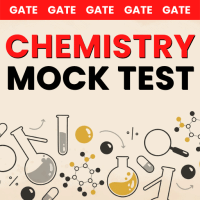Chemistry Exam > Chemistry Questions > The amino acid side chain high affinity for C...
Start Learning for Free
The amino acid side chain high affinity for Ca2+ and Cu2+ in metallo–proteins is:
- a)Carboxylate in both the cases.
- b)Imidazole in both the cases.
- c)Carboxylate for Ca2+ and imidazo le for Cu2+.
- d)Imidazole for Ca2+ and carboxylate for Cu2+.
Correct answer is option 'C'. Can you explain this answer?
Most Upvoted Answer
The amino acid side chain high affinity for Ca2+ and Cu2+ in metallo&#...
Metalloproteins are proteins that contain metal ions as an integral part of their structure and function. The amino acid side chains in these proteins have a high affinity for metal ions such as Ca2+ and Cu2+. The correct answer is option C, which states that carboxylate is the high-affinity side chain for Ca2+ and imidazole is the high-affinity side chain for Cu2+.
Carboxylate Side Chain for Ca2+
The carboxylate side chain is a negatively charged group that is present in amino acids such as aspartate and glutamate. This side chain has a high affinity for metal ions such as Ca2+ due to its negative charge. Ca2+ ions are essential for many biological processes such as muscle contraction, neurotransmitter release, and blood clotting. Metalloproteins that bind Ca2+ ions include calmodulin, troponin C, and osteocalcin.
Imidazole Side Chain for Cu2+
The imidazole side chain is a nitrogen-containing group that is present in the amino acid histidine. This side chain has a high affinity for metal ions such as Cu2+ due to its ability to coordinate with the metal ion through its nitrogen atoms. Cu2+ ions are essential for many biological processes such as electron transport, oxidative metabolism, and iron absorption. Metalloproteins that bind Cu2+ ions include ceruloplasmin, cytochrome c oxidase, and dopamine β-hydroxylase.
In conclusion, the amino acid side chains in metalloproteins have a high affinity for metal ions such as Ca2+ and Cu2+. The carboxylate side chain is the high-affinity side chain for Ca2+ ions, while the imidazole side chain is the high-affinity side chain for Cu2+ ions.
Carboxylate Side Chain for Ca2+
The carboxylate side chain is a negatively charged group that is present in amino acids such as aspartate and glutamate. This side chain has a high affinity for metal ions such as Ca2+ due to its negative charge. Ca2+ ions are essential for many biological processes such as muscle contraction, neurotransmitter release, and blood clotting. Metalloproteins that bind Ca2+ ions include calmodulin, troponin C, and osteocalcin.
Imidazole Side Chain for Cu2+
The imidazole side chain is a nitrogen-containing group that is present in the amino acid histidine. This side chain has a high affinity for metal ions such as Cu2+ due to its ability to coordinate with the metal ion through its nitrogen atoms. Cu2+ ions are essential for many biological processes such as electron transport, oxidative metabolism, and iron absorption. Metalloproteins that bind Cu2+ ions include ceruloplasmin, cytochrome c oxidase, and dopamine β-hydroxylase.
In conclusion, the amino acid side chains in metalloproteins have a high affinity for metal ions such as Ca2+ and Cu2+. The carboxylate side chain is the high-affinity side chain for Ca2+ ions, while the imidazole side chain is the high-affinity side chain for Cu2+ ions.
Free Test
FREE
| Start Free Test |
Community Answer
The amino acid side chain high affinity for Ca2+ and Cu2+ in metallo&#...
C

|
Explore Courses for Chemistry exam
|

|
Question Description
The amino acid side chain high affinity for Ca2+ and Cu2+ in metallo–proteins is:a)Carboxylate in both the cases.b)Imidazole in both the cases.c)Carboxylate for Ca2+ and imidazo le for Cu2+.d)Imidazole for Ca2+ and carboxylate for Cu2+.Correct answer is option 'C'. Can you explain this answer? for Chemistry 2025 is part of Chemistry preparation. The Question and answers have been prepared according to the Chemistry exam syllabus. Information about The amino acid side chain high affinity for Ca2+ and Cu2+ in metallo–proteins is:a)Carboxylate in both the cases.b)Imidazole in both the cases.c)Carboxylate for Ca2+ and imidazo le for Cu2+.d)Imidazole for Ca2+ and carboxylate for Cu2+.Correct answer is option 'C'. Can you explain this answer? covers all topics & solutions for Chemistry 2025 Exam. Find important definitions, questions, meanings, examples, exercises and tests below for The amino acid side chain high affinity for Ca2+ and Cu2+ in metallo–proteins is:a)Carboxylate in both the cases.b)Imidazole in both the cases.c)Carboxylate for Ca2+ and imidazo le for Cu2+.d)Imidazole for Ca2+ and carboxylate for Cu2+.Correct answer is option 'C'. Can you explain this answer?.
The amino acid side chain high affinity for Ca2+ and Cu2+ in metallo–proteins is:a)Carboxylate in both the cases.b)Imidazole in both the cases.c)Carboxylate for Ca2+ and imidazo le for Cu2+.d)Imidazole for Ca2+ and carboxylate for Cu2+.Correct answer is option 'C'. Can you explain this answer? for Chemistry 2025 is part of Chemistry preparation. The Question and answers have been prepared according to the Chemistry exam syllabus. Information about The amino acid side chain high affinity for Ca2+ and Cu2+ in metallo–proteins is:a)Carboxylate in both the cases.b)Imidazole in both the cases.c)Carboxylate for Ca2+ and imidazo le for Cu2+.d)Imidazole for Ca2+ and carboxylate for Cu2+.Correct answer is option 'C'. Can you explain this answer? covers all topics & solutions for Chemistry 2025 Exam. Find important definitions, questions, meanings, examples, exercises and tests below for The amino acid side chain high affinity for Ca2+ and Cu2+ in metallo–proteins is:a)Carboxylate in both the cases.b)Imidazole in both the cases.c)Carboxylate for Ca2+ and imidazo le for Cu2+.d)Imidazole for Ca2+ and carboxylate for Cu2+.Correct answer is option 'C'. Can you explain this answer?.
Solutions for The amino acid side chain high affinity for Ca2+ and Cu2+ in metallo–proteins is:a)Carboxylate in both the cases.b)Imidazole in both the cases.c)Carboxylate for Ca2+ and imidazo le for Cu2+.d)Imidazole for Ca2+ and carboxylate for Cu2+.Correct answer is option 'C'. Can you explain this answer? in English & in Hindi are available as part of our courses for Chemistry.
Download more important topics, notes, lectures and mock test series for Chemistry Exam by signing up for free.
Here you can find the meaning of The amino acid side chain high affinity for Ca2+ and Cu2+ in metallo–proteins is:a)Carboxylate in both the cases.b)Imidazole in both the cases.c)Carboxylate for Ca2+ and imidazo le for Cu2+.d)Imidazole for Ca2+ and carboxylate for Cu2+.Correct answer is option 'C'. Can you explain this answer? defined & explained in the simplest way possible. Besides giving the explanation of
The amino acid side chain high affinity for Ca2+ and Cu2+ in metallo–proteins is:a)Carboxylate in both the cases.b)Imidazole in both the cases.c)Carboxylate for Ca2+ and imidazo le for Cu2+.d)Imidazole for Ca2+ and carboxylate for Cu2+.Correct answer is option 'C'. Can you explain this answer?, a detailed solution for The amino acid side chain high affinity for Ca2+ and Cu2+ in metallo–proteins is:a)Carboxylate in both the cases.b)Imidazole in both the cases.c)Carboxylate for Ca2+ and imidazo le for Cu2+.d)Imidazole for Ca2+ and carboxylate for Cu2+.Correct answer is option 'C'. Can you explain this answer? has been provided alongside types of The amino acid side chain high affinity for Ca2+ and Cu2+ in metallo–proteins is:a)Carboxylate in both the cases.b)Imidazole in both the cases.c)Carboxylate for Ca2+ and imidazo le for Cu2+.d)Imidazole for Ca2+ and carboxylate for Cu2+.Correct answer is option 'C'. Can you explain this answer? theory, EduRev gives you an
ample number of questions to practice The amino acid side chain high affinity for Ca2+ and Cu2+ in metallo–proteins is:a)Carboxylate in both the cases.b)Imidazole in both the cases.c)Carboxylate for Ca2+ and imidazo le for Cu2+.d)Imidazole for Ca2+ and carboxylate for Cu2+.Correct answer is option 'C'. Can you explain this answer? tests, examples and also practice Chemistry tests.

|
Explore Courses for Chemistry exam
|

|
Signup for Free!
Signup to see your scores go up within 7 days! Learn & Practice with 1000+ FREE Notes, Videos & Tests.


















